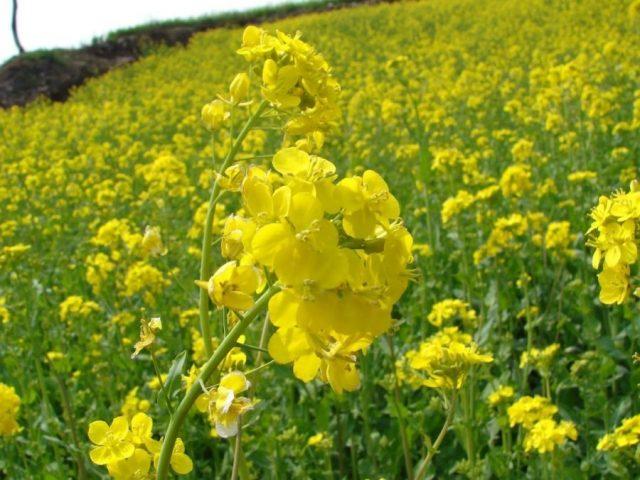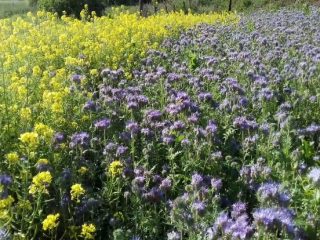Content
Green manure for the garden in the spring helps prepare the soil for planting vegetables and grain crops. Some plants are better suited for weed control and soil enrichment than others.
The best green manure for the garden in the spring against weeds
Fast-growing green manure in the spring helps loosen the soil and improve its aeration, prevent the growth of weeds and saturate the soil with useful substances. For planting on the site and in the greenhouse, it is especially recommended to use several crops.
Vika
A plant of the legume family should be planted in the area in front of tomatoes and cabbage. Vetch enriches the substrate with nitrogen, is characterized by early ripening, increases the yield of vegetable crops and prevents the development of weeds. The plant develops well on fertile, loose soil. It is better not to place vetch on sandy and too salty soil.

It is better to plant vetch in spring on neutral soils; it does not tolerate acidic soil well.
Phacelia
A good green manure for spring sowing is phacelia, which is characterized by its unpretentiousness and rapid growth. The crop is planted in front of beets, carrots and potatoes to protect vegetables from weeds and pests. The plant improves the quality of the substrate, increases breathability and stops erosion. You can mow green manure in spring just 50 days after planting. Phacelia can be placed on poor sandy soil to increase its nutritional value.

Phacelia is frost-resistant; it can be sown as green manure as early as mid-March
Mustard
A video for beginners on how to sow green manure in the spring; white mustard is recommended for planting. The plant ripens within two months, produces a large amount of green mass and suppresses weeds well in the garden. The powerful root system of mustard loosens the soil in the spring and improves its breathability.
The crop can be planted on poor, light soil. Mustard is unpretentious, but does not tolerate wetlands and acidic soil.

Mustard in the spring protects cultivated plantings from fusarium and late blight
Lupine
A good green manure plant for the garden to control weeds in the spring is tall lupine. The culture develops quickly and increases the fertility of poor soil, ideal for enriching the soil in problem and abandoned areas in the garden.
Lupine should be sown in spring two months before planting vegetables and grains. The perennial grows best on a light, acidified substrate. But if necessary, it can also be planted on loam and sandy soil.

Lupine in the spring saturates the soil not only with nitrogen, but also with potassium, as well as phosphorus
Alfalfa
You can plant alfalfa as green manure in spring in open ground. The plant has good germination rates and does not have strict care requirements. It is recommended to sow seeds from the end of April, in which case at the beginning of summer the crop will gain a sufficient amount of green mass.
Alfalfa is a good green manure for acidic soil in the spring because it normalizes the pH level. It is recommended to plant it on well-moistened, but not swampy soil. The plant does not tolerate rocky and clay soil, develops slowly and often gets sick in salt marshes.

Alfalfa in the spring not only fights weeds, but also helps prevent the appearance of nematodes
Rye
Rye is not only a useful cultivated plant, but also a good green manure for planting in the spring. It enriches the substrate with nitrogen and potassium, and also suppresses the development of creeping wheatgrass, one of the most problematic weeds. Rye is often used to improve the composition of the soil in new areas.
The crop is characterized by low seed consumption - per 1 m2 Only 20 g of grains are sown. You can plant rye in the area in front of any vegetables.

Rye should not be sown in spring after cereal plants.
Buckwheat
Buckwheat can be used as green manure for poor acidified soil in spring. The culture is unpretentious, stops the growth of weeds and fights wheatgrass on the site. After mowing, it enriches the soil with phosphorus and potassium, as well as nitrogen.
Buckwheat has powerful roots and loosens the soil to a depth of 2 m. The crop can be planted in front of tomatoes and cucumbers. It will protect vegetables from pests and increase yields.

Buckwheat has low frost resistance, so it is planted in the spring no earlier than the beginning of May.
Clover
White, red and pink clover are often used as green manure in the spring because they add nitrogen to the soil and also prevent erosion. The plant is sown from mid-April, the seed consumption rate is about 2 g per 1 m2. You need to mow the crop two weeks before planting vegetables so that the greens have time to decompose.

Clover is not recommended to be sown on the site in the spring after legumes
Oats
Oats can serve as a good green manure for sowing in spring. The plant has well-developed roots and effectively loosens the soil, promoting its saturation with oxygen. Oats inhibit the development of weeds and also saturate the soil with vitamins and minerals. The stems of the plant contain a lot of protein, which is very useful for vegetable crops.
You can plant oats in spring on almost any soil, even clayey and heavy soil. Consumption is about 30 g of seeds per 1 m2.

You can sow oats as green manure together with vetch and peas.
Rape
Useful green manure enriches the soil with sulfur, phosphorus and organic matter. It is characterized by rapid growth and produces abundant green mass. It is useful to plant rapeseed on dense soil, since the powerful roots of the crop loosen the soil well.
The plant contains a large amount of essential oils. Thanks to this feature, rapeseed protects vegetable crops from pests and fungi. The perennial in the spring helps eliminate weeds, prevents erosion and protects the soil from erosion.

Rapeseed tolerates short-term drought well and does not require frequent watering during the growth period
Sweet clover
The biennial plant is used for planting in the spring to increase soil fertility and make it looser. Sweet clover can be planted on sandy and highly saline soil. The plant is cold-resistant and tolerates drought well and does not require complex care. You can use sweet clover to protect your garden from nematodes and wireworms, as well as to prevent fungal diseases. The crop fights weeds well.

Sweet clover is a honey plant, attracts bees and improves the quality of pollination of cultivated plants
Olive radish
The fast-growing green manure is unpretentious and is optimally suited for improving heavy clay soil. Due to its long powerful roots, it loosens the soil well and increases its breathability, fights bacteria and fungi thanks to the essential oils in the composition. You can use radish to protect your garden from weeds and pests. The perennial will be especially useful if wireworms and nematodes often appear in the garden.

When planting radishes in spring on acidic soil, it is advisable to first treat the soil with lime or ash.
When to plant green manure in spring
Green manure can be planted in spring at a temperature of 5-10 °C. The exact indicators depend on the specific crop. Some plants are highly cold-resistant, others are afraid of night frosts.
In general, it is recommended to wait until the ground has thawed properly after winter. In the middle zone, green manure is most often planted in mid-April, in the southern regions - at the end of March.If sowing is to be carried out in an area where vegetable crops will be placed no earlier than July, the procedure is postponed until May. Green manure should be planted so that it can develop in the soil within 1.5-2 months. Otherwise, the plants will not have time to gain enough green mass.
How to sow green manure in the spring in the garden
Planting green manure in spring in open ground is carried out according to the same scheme, regardless of the plant chosen. The algorithm looks like this:
- The area is cleared of remaining branches, leaves and other plant debris.
- The soil is carefully dug up and loosened.
- The seeds are scattered over the surface, trying to distribute them as evenly as possible.
- Using a rake, loosen the soil again to slightly deepen the planting material.
- Moisten the area generously with a watering can or sprayer.
To make sowing more convenient in the spring, you can pre-mix the seeds with sawdust or sand. This will allow the planting material to be distributed as evenly as possible in the soil.
Features of planting green manure in spring in a greenhouse
Sowing green manure in spring in a greenhouse is no more difficult than in open ground. The procedure is performed according to the following scheme:
- They dig up the soil in the greenhouse and disinfect it from possible fungi and pests.
- All plant debris from last year is removed from the greenhouse.
- Loosen the soil and evenly sow the greenhouse with green manure over the entire area.
- Water the soil generously with lukewarm, settled water.
Planting green manure in a greenhouse has only one feature. Seeds must be planted in the soil no later than 6-7 weeks before sowing vegetable crops. Useful plants must gain enough green mass, otherwise they will not be of much use.
When and how to bury
After sowing green manure in the spring, in order to improve the soil, it is necessary to mow the sprouted plants in a timely manner. Harvesting is usually done 6-8 weeks after planting. By this time, most useful plants have time to get stronger and prepare for flowering.
Green manure must be mowed before it produces buds. During the decorative period, the stems of plants become rigid and decompose much more slowly in the soil. In addition, the main part of the nutrients goes into flowers and developing fruits. Therefore, during the process of decomposition, grasses no longer give the maximum amount of vitamins and organic substances to the soil.
Harvesting of plants intended to improve the soil composition is carried out according to the following algorithm:
- Cut the green stems with a scythe or sickle almost flush with the ground.
- Plow up the substrate and embed raw materials into it to a depth of about 5 cm.
- Water the soil generously to provide the greenery with favorable conditions for decomposition.
It is necessary to sow main crops in open soil or in a greenhouse 1-2 weeks after harvesting useful herbs. During this time, green manure in the spring will have time to improve the structure of the substrate and increase its breathability.

It is not customary to leave green manure on the ground surface in the spring; the mulching method is usually used in the fall
If it is necessary to attract pollinators to the site, some of the beneficial herbs are left to develop in the soil. Plants that are of interest to bees will promote more abundant flowering and establishment of vegetable crops.
Conclusion
Green manure for the garden in the spring can improve the quality of the soil on the site. Embedding plant matter into the soil protects vegetable and grain crops from diseases and pests and increases productivity.In addition, green manure suppresses the development of weeds.
Reviews of green manure for the garden in spring








